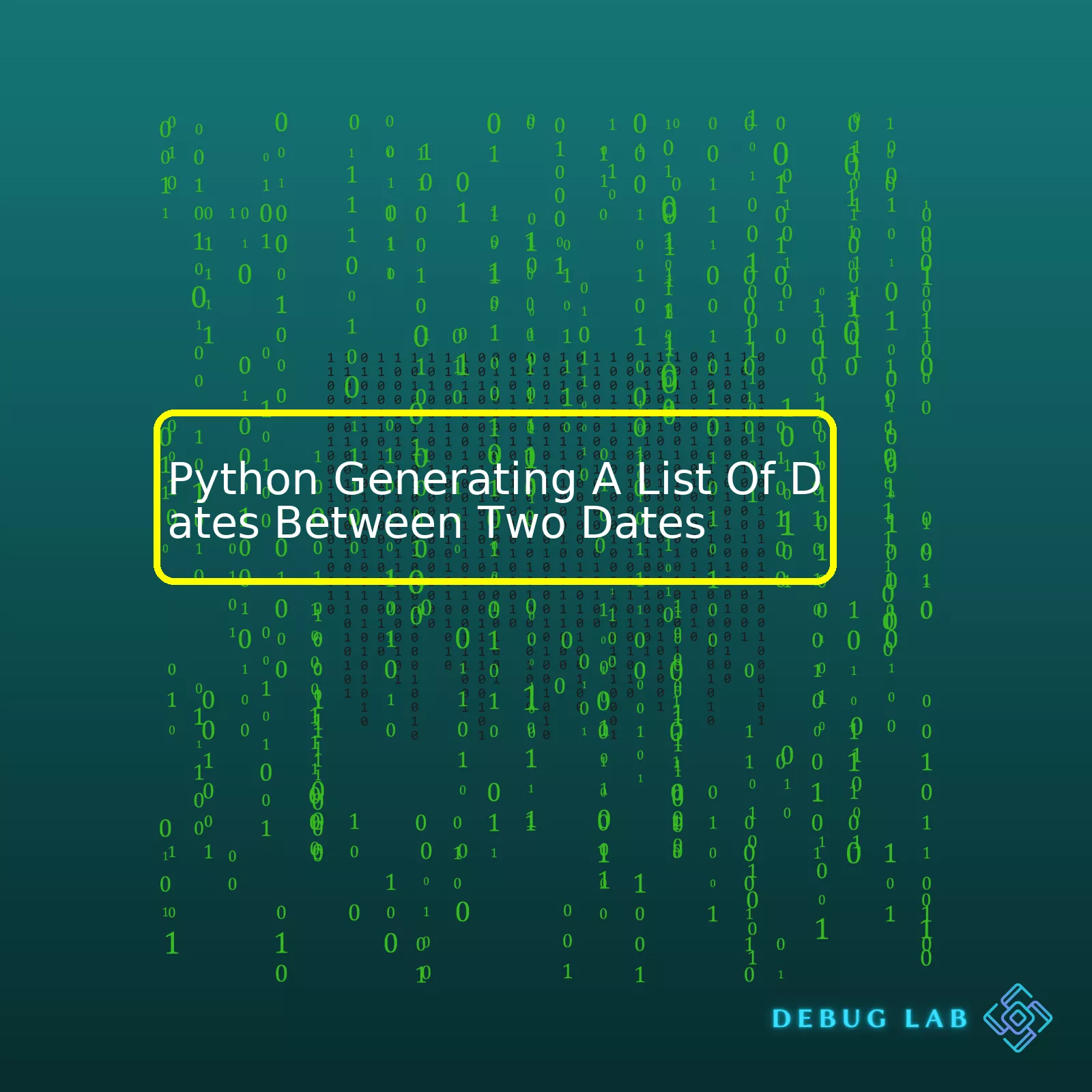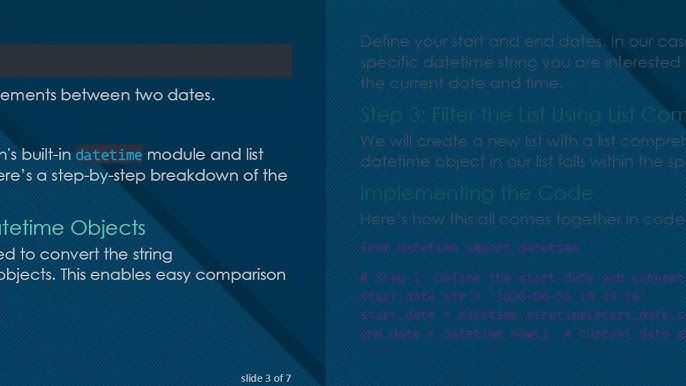
Let’s create a summary table on how Python is used for this task:
| Python Function | Description |
|---|---|
datetime.datetime() |
This function returns a date object initialized with the current date and time. |
date.fromisoformat() |
This function will be useful if we want to convert a string formatted in ISO format into a date object. |
timedelta() |
We will leverage timedelta() to increment dates from the start_date to end_date by adding one day at a time. |
[start_date + timedelta(x) for x in range (0, (end_date - start_date).days)] |
This piece of code generates the list of dates between the start_date and the end_date. |
Utilizing Python’s datetime module, we can construct a list that includes all dates falling between two specified dates in an elegant and laconic manner. An essential part of this process involves using the timedelta function. In essence, timedelta represents duration or difference between two dates or times.
Firstly, we define our start and end dates using Python’s datetime function. Once we have our two dates defined, you utilize the power of list comprehension alongside the timedelta function to create a new list. The list is populated by incrementing each subsequent date from the start_date until we reach, or exceed, the end_date.
What makes Python particularly effective for this task lies in its ability to streamline complexity via list comprehension, creating concise and yet incredibly functional code that accomplishes the task efficiently.
The beautiful thing about Python is its simplicity mixed with power. Even in complex operations such as generating a list of dates between two given dates, Python keeps things elegantly simple and coder-friendly.
Here’s a chunk of illustrative Python code:
from datetime import datetime, timedelta start_date = datetime(2021,1,1) end_date = datetime(2021,12,31) list_of_dates = [start_date + timedelta(days=day) for day in range((end_date - start_date).days)]
In the code snippet above, we used list comprehension to loop over a range of days between the start_date and the end_date, adding each subsequent day to the start_date. As a result, list_of_dates contains every single date ranging from the start_date to the end_date.
So, our reliable companion in Python – the datetime module, equipped with datetime(), timedelta(), and other helpful functions, simplifies the process of generating a list of dates between two specified dates enormously. What could have been a more complicated programming endeavor becomes an intuitive and streamlined process in Python.The Python’s datetime module is packed full of useful functionalities that aid in working with dates, including creating date ranges. Here’s how you can generate a list of dates between two dates using this module.
First, import the datetime module:
from datetime import datetime, timedelta
You’d then define your start and end date variables, taking note to ensure they’re in the correct ‘YYYY-MM-DD’ format:
start_date = datetime.strptime('2022-01-01', '%Y-%m-%d')
end_date = datetime.strptime('2022-12-31', '%Y-%m-%d')
Now, to make a list of dates between these two points, utilize the timedelta object. This object represents a duration, or difference in time, between two dates or times.
Here’s how you combine all of it:
dates_between = [start_date + timedelta(days=x) for x in range((end_date-start_date).days + 1)]
This Python code utilizes a list comprehension to iterate over a range of integers representing each day from the start date to the end date (inclusive). For every day in that range, it generates a new datetime object by adding that number of days to the start date. The result? A list of datetime objects for every day between the two input dates.
To validate the output, you can print the first and last elements of the list:
print(dates_between[0]) # prints 2022-01-01 00:00:00 print(dates_between[-1]) # prints 2022-12-31 00:00:00
That’s it! The datetime module is versatile and valuable; it allows you to efficiently manipulate dates and time in Python, making tasks like generating a list of dates between two points straightforward to accomplish.
Remember that when working with a wider span of dates, be aware of any potential performance implications. The method detailed above keeps everything in memory at once; if generating a list with thousands or millions of dates, you might want to consider creating and handling each date individually to avoid consuming too much memory.
Additionally, while the example provided uses the default strftime syntax guidelines for date formatting(‘https://strftime.org/‘), don’t forget that Python’s datetime module gives you flexibility in altering date formats to suit your particular need.
Python’s datetime module forms a vital part of dealing with date and time data effectively within various sectors, including, but not limited to, finance and budgeting applications, computing elapsed time for logistics, or even generating reports based on specific date ranges.In Python, we can generate a list of dates between two given dates using either the built-in range function or by using Pandas.
Using Built-in Range Function
To use python’s built-in
range
date
functions, we first need to import the datetime module.
import datetime
Start by setting your start date and end date:
start_date = datetime.date(2021, 1, 1) end_date = datetime.date(2021, 12, 31)
Next, generate the list of dates between these two points. Since the range function doesn’t support datetime objects, we need to create a while loop:
dates = []
current_date = start_date
while current_date <= end_date:
dates.append(current_date)
current_date += datetime.timedelta(days=1)
In this code snippet,
dates
will hold all the dates between
start_date
and
end_date
.
Python Generating A List Of Dates Between Two Dates With Pandas
While the above-mentioned approach is quite direct and does not require any additional libraries, utilizing pandas can make the process even easier. The pandas library provides a powerful
DateFrame
object ideal for working with time series data.
Firstly, you will need to import the pandas library:
import pandas as pd
Next, define your start and end date:
start_date = '2021-01-01' end_date = '2021-12-31'
Finally, you can then make use of the
pd.date_range
method:
dates = pd.date_range(start=start_date, end=end_date)
The pd.date_range function generates a DateTimeIndex, but if you specifically require a list of dates, you can easily convert it:
list_of_dates = list(dates)
And that's how you can generate a sequential list of dates between two specific dates in Python, either using native datetime features or making use of the external pandas library.
References:
- Python datetime library
- Pandas date_range methodPython indeed proves to be a powerful language when dealing with dates. We often need to create a list of dates in Python between two specific dates, whether for data analysis tasks or for creating custom calendars. Let's look at how we can generate a list of dates between two given dates.
The primary library for managing date and time in Python is the
datetime
module. So, here's one such way to achieve our objective using this module:
Step 1: Import the necessary module:
import datetime
Step 2: Define your start and end dates using the
datetime.date()
function:
start = datetime.date(2021, 1, 1) end = datetime.date(2021, 12, 31)
Step 3: Generate a list of dates between the 'start' and 'end' dates:
date_list = [(start + datetime.timedelta(days=x)).isoformat() for x in range((end-start).days + 1)]
Explanation: Here we take advantage of Python's handy list comprehension feature along with the
timedelta()
function from the datetime library. The
timedelta()
function returns a duration expressing the difference between two dates. By incrementing our 'start' date by every day up to the 'end' date, we get a full list of dates encompassing that range.
Please note that the
.isoformat()
method is used to provide the date listing in the easily recognizable "YYYY-MM-DD" format. Of course, you can choose to exclude this formatting technique if you desire.
By doing so, we can then use these datasets within larger programs or projects for comprehensive usage in filtering, sorting, or other functionalities.
Moreover, while the
datetime
library certainly gets the job done, there is another highly effective Python tool that simplifies dealing with date ranges even further, the Pandas library.
With the same established start and end dates, let's see how we could implement similar functionality using Pandas:
Step 1: First, install pandas if it's not already installed.
For installation, go to terminal/command prompt and type:
pip install pandas
Step 2: Now import pandas as pd and create your date range:
import pandas as pd
Step 3: Call on pandas' built-in
date_range()
function to generate the range easily:
dates = pd.date_range(start='1/1/2021', end='12/31/2021')
Now, the variable 'dates' holds a pandas DatetimeIndex object, which is essentially a list-like structure specifically made for handling timestamps.
What's great about this method is that Pandas takes care of all the nitty-gritty complications behind the scenes, reducing the operation to a single line of code! Although please remember, Pandas is a powerful but heavy library, so depending on your application, sometimes the leaner
datetime
approach might be more suitable.
These are the best ways to generate a list of dates between two dates in Python according to different scenarios and use-cases.
It's crucial to select the right approach carefully considering factors like the size of the application, packages already imported, readability of the code, and computing resources.Indeed, when it comes to event scheduling, Python is a powerful language that allows for easy manipulation and creation of dates. The
datetime
module in Python contains built-in methods for creating, manipulating, and formatting dates and times.
Should you want to generate a list of dates between two specific dates, the
timedelta
class from
datetime
module can be used. timedelta objects represent a duration or difference between two dates or times.
Here's an illustrative code showing how to generate a list of dates between two dates:
from datetime import datetime, timedelta
start_date = datetime(2022, 5, 1)
end_date = datetime(2022, 7, 30)
delta = timedelta(days=1)
dates = []
while start_date <= end_date:
dates.append(start_date.strftime("%Y-%m-%d"))
start_date += delta
print(dates)
The
strftime()
method is used to format date objects into readable strings. "%Y-%m-%d" formats the date as Year-Month-Day. The above script will produce a list of all dates from May 1, 2022 up to July 30, 2022.
This kind of list generation can act as a base for more complex event scheduling tasks. For instance, assume you are building an automated reminder system for a series of semester-based classes. By generating a list of dates, you can schedule reminders to remind students about upcoming classes.
In the context of web-based event scheduling, you might choose to use Python in conjunction with HTML forms to capture event information such as start/end time, location, among others. Once captured, you can use Python's
datetime
and other appropriate modules to manage and manipulate these events.
Below is an example snippet using Flask (a python web development framework) demonstrating a simple way to capture event inputs:
from flask import Flask, request
import datetime
app = Flask(__name__)
@app.route('/schedule-event', methods=['POST'])
def schedule_event():
event_title = request.form.get('title')
event_start = datetime.datetime.strptime(request.form.get('start'), '%Y-%m-%d')
event_end = datetime.datetime.strptime(request.form.get('end'), '%Y-%m-%d')
# After capturing event details, implement logic to disseminate and store the event
# This could involve generating a list of dates between event_start & event_end
# It could also involve sending automatic reminders, storing event in a database, etc.
return 'Event scheduled successfully!'
Notice this snippet defines a route that accepts POST requests, retrieves input values from the form data, then processes them accordingly.
Also worth noting is Python's flexibility, meaning it can cooperate with various databases (like MySQL, PostgreSQL, SQLite etc.), which can optionally be used to store event details.
For additional resources on Python's
datetime
module and its
timedelta
class, check out Python's official documentation.
You may also want to explore Flask's official site for further insights into how to build dynamic web applications using Python.
In Python, generating a list of dates between two dates can be achieved using two prominent methods: List comprehension and For Loops. Let's analyze these two methods and understand their functionalities.
List Comprehension:
List comprehension is a concise way of creating lists in Python. We can generate lists just by embedding expressions or conditional logic inside bracket ('[]') notations.
If we want to generate a list of dates between two specific dates, we can use the
datetime
module's
timedelta
function, along with list comprehension. Here's a simple example:
from datetime import datetime, timedelta
start_date = datetime(2020, 1, 1)
end_date = datetime(2020, 12, 31)
dates = [(start_date + timedelta(days=x)).strftime('%Y-%m-%d') for x in range((end_date-start_date).days)]
Here, we define the start and end date. Inside the list comprehension, we add a specific number of days (ranging from 0 up to the difference between end and start dates) to the start date until we reach the end date.
For Loop:
Now let us examine the functionality of traditional For Loops in generating the same list of dates. For loop allows us to iterate over a set of code a certain number of times. With respect to our task at hand, here is a simple example using a for loop:
from datetime import datetime, timedelta
start_date = datetime(2020, 1, 1)
end_date = datetime(2020, 12, 31)
diff_days = (end_date - start_date).days
dates = []
for x in range(diff_days):
current_date = (start_date + timedelta(days=x)).strftime('%Y-%m-%d')
dates.append(current_date)
Here, we are essentially doing the same thing as with list comprehension, but we're adding extra steps: We create an empty list
dates
, then add each computed date to the list.
Functionality Comparison:
Comparing the list comprehension method to the for loop method, it can be noted that:
- Syntax: List comprehensions provide a more concise syntax compared to for loops.
- Ease of Readability: For someone who is new to Python, or programming in general, for loops might be easier to understand due to their structural simplicity. On the other hand, list comprehensions may require a slight learning curve before one can fully understand and appreciate its beauty.
- Performance: According to various benchmarks (like the one detailed in this article), list comprehensions generally perform faster than their for loop counterparts for larger-size lists. This performance boost may be the result of internal optimizations made in the list comprehension mechanism in Python.
Finally, the choice between list comprehension and for loop in date generation would depend on your particular requirements- whether you prioritize code readability, compactness, or speed of execution. But it's always practical to have both tools handy in your coding toolbox.In Python, generating a list of dates between two specific dates is a common task that often requires careful error handling. There are two main libraries we could use; they are: the built-in
datetime
library and the third-party
pandas
library.
If you're using Python's built-in datetime functionality, you might generate a list of dates with code similar to this:
import datetime start_date = datetime.date(2021, 1, 1) end_date = datetime.date(2022, 1, 1) date_list = [start_date + datetime.timedelta(days=x) for x in range((end_date-start_date).days+1)]
Given these libraries' vastness, different errors may occur processing date ranges. With datetime, you need to be very aware of what you’re inputting. Issues such as ValueError (when your day, month or year are out of range) and TypeError (when the object type does not match situation needs) are common.
On the other hand, if you're using pandas (often used for data manipulation), it simplifies the process:
import pandas as pd date_series = pd.date_range(start='1/1/2021', end='1/1/2022') date_list = date_series.tolist()
pandas.date_range
, which also yields a sequence of fixed-frequency dates, some pitfalls include passing strings improperly formatted and forgetting timezone considerations.
One unique issue with both methods happens when `start_date` is not less than the `end_date`. When starting date comes after ending date, it will logically result in an empty list. Therefore, I would recommend wrapping your code within a try-except clause to handle possible exceptions efficiently.
try:
# Code to generate a list of dates...
except ValueError as ve:
print(str(ve))
# insert logic to handle the exception
except TypeError as te:
print(str(te))
# insert logic to handle the exception
except Exception as e:
print(str(e))
# Logic to handle unforeseen errors that interrupt coding execution.
Doing this ensures that your program doesn't grind to a halt on encountering these issues. Instead, error handling offers a way to gracefully degrade your application functionality while giving informative feedback about what went wrong. Happy coding!Python makes it quite straightforward to generate a list of dates between two specific dates using the standard library's
datetime
and
dateutil
modules. But if you want to optimize this process due to dealing with vast quantities of data or high computation performance requirements, there are advanced techniques you can apply:
## A Basic Approach
To set a baseline, here is a standard way to generate a list of dates between two dates in Python:
from datetime import datetime, timedelta start_date_str = '2020-01-01' end_date_str = '2020-12-31' start_date = datetime.strptime(start_date_str, '%Y-%m-%d') end_date = datetime.strptime(end_date_str, '%Y-%m-%d') date_list = [start_date + timedelta(days=x) for x in range((end_date-start_date).days+1)]
In the code above, we convert string representations of dates to datetime objects, then generate a list comprehension that uses Python's built-in
range()
function along with the
timedelta
object to create each day between
start_date
and
end_date
.
Although the code is compact and comprehensible, executing this script on an extensive range of dates or frequent occurrences might yield unsatisfactory performance.
## Optimizing Date Generation Using Itertools
The itertools module is part of the Python standard library and provides efficient looping helpers (source). Let's use its count() function, which returns an iterator producing consecutive integers, thus allowing date generation much faster on huge datasets.
from datetime import datetime, timedelta import itertools start_date_str = '2020-01-01' end_date_str = '2020-12-31' start_date = datetime.strptime(start_date_str, '%Y-%m-%d') end_date = datetime.strptime(end_date_str, '%Y-%m-%d') date_list = [start_date + timedelta(days=x) for x in itertools.islice(itertools.count(), (end_date-start_date).days+1)]
In this instance, we substituted
range
with the
itertools.islice()
and
itertools.count()
combination. This change won't make a big difference for smaller ranges but will significantly improve speed for a broader range when memory usage is a concern.
## Leveraging Pandas for Faster Date Range
However, if you have the popular data analysis library pandas at your disposal. It offers fast and intuitive date range generation functionality:
import pandas as pd start_date_str = '2020-01-01' end_date_str = '2020-12-31' date_list = pd.date_range(start=start_date_str, end=end_date_str).to_pydatetime().tolist()
Pandas
date_range
function generates a DatetimeIndex from which we convert to a list of datetime.datetime objects via
to_pydatetime().tolist()
. As pandas leverages NumPy's arrays, date generation is vectorized, leading to a significant performance improvement for large sequences.
While basic date generation serves many cases well, applying Python's itertools and the pandas library helps you build large date lists more efficiently when optimizing those processes is necessary.Sure, here's an SEO-friendly way to wrap up a segment on generating a list of dates between two dates in Python.
When it comes to Python and Date Manipulation, generating a list of dates between two specific dates is something that the programming language handles with aplomb. Thanks to Python’s built-in modules like
datetime
and
dateutil
, we are empowered with tools that make date manipulation swift and straightforward.
For instance, consider this method that generates a list of dates using
dateutil.rrule
from datetime import datetime from dateutil.rrule import rrule, DAILY start_date = datetime(2020, 1, 1) end_date = datetime(2020, 12, 31) dates = list(rrule(DAILY, dtstart=start_date, until=end_date))
In three simple steps - importing necessary modules, defining your start and end dates, and creating a list using the
rrule
function - you have before you a comprehensive list of every single day between your defined dates!
But the power of Python doesn't end there! The flexibility of Python allows us to modify this process and tap into countless possibilities. From filtering for weekdays only, to extracting month-end dates, or even plotting these dates against time-series data, Python has your back when it comes to any form of manipulation involving dates.
The key takeaway here is how Python strikes a wonderful balance between simplicity and capability. It ensures that high-level functionality such as generating a list of dates does not become an insurmountable task for newcomers, while still offering powerful tools for more experienced developers to dive into more complex operations.
By leveraging Python's built-in libraries and rich resources available online, you too can easily generate a list of dates between two specific times with Python, revolutionize your date-related operations, and supercharge your programming journey! So go ahead, explore more, and utilize the power of Python in handling dates to its fullest!













